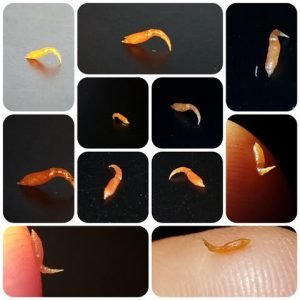
The wolf worm, typically a maggot, can invade a squirrel’s body and set up shop, causing all sorts of problems. It’s like having an unwanted guest who just won’t leave! Understanding how to identify the symptoms of wolf worms and managing their presence is crucial for the health of these lively little creatures. So, let’s dive into some details to help you become more familiar with what these worms are and how you can care for a squirrel in need.
What Are Wolf Worms?
Wolf worms are the larvae of certain flies, primarily the *Cuterebra* species. These flies lay their eggs near burrows or nests of small mammals like squirrels. When the eggs hatch, the larvae latch onto the host and start their journey into the squirrel’s body. It’s a bit like a surprise party that nobody wanted!
Once inside, these larvae can live in the host’s skin or even migrate to other organs. They typically don’t kill their host immediately, but they can lead to a range of health issues. The presence of wolf worms in squirrels can create discomfort, pain, and sometimes serious infections. Honestly, it’s not a fun experience for the squirrel or the person observing their struggle.
Symptoms of Wolf Worm Infestation
Identifying wolf worms in squirrels isn’t as straightforward as it sounds. Here are some common symptoms to look out for:
- Swelling and lumps: One of the most noticeable signs is swelling around the area where the larvae are located. This might look like a large, sore lump on the squirrel’s body.
- Restlessness or irritability: A squirrel that usually bounds around your yard might start acting differently. If they’re more irritable or restless, it could be due to discomfort caused by the worms.
- Wound or discharge: In some cases, you might notice an open wound or some oozing discharge. The larvae can create a hole in the skin to breathe, leading to further complications.
- Weight loss and weakness: If a squirrel has a significant worm infestation, it might start losing weight or appear weaker than usual.
If you observe any of these symptoms, it’s important to act quickly! You might be wondering how you can help them, so let’s explore that.
How to Manage Squirrels with Wolf Worms
Managing wolf worms in squirrels is crucial for their health and well-being. Here’s a step-by-step guide on what you can do if you suspect a squirrel is infested:
1. Observe and Assess
Before jumping into action, take some time to observe the squirrel closely. Look for signs mentioned earlier, like swelling or unusual behavior. Ensure that the squirrel seems to be unable to cope alone—it’s essential to confirm that it needs help.
2. Contact Wildlife Rehabilitation
It’s critical not to try treating the squirrel yourself. Instead, reach out to a local wildlife rehabilitation center or a veterinarian with experience in treating wild animals. They can provide the appropriate treatment and care that a squirrel needs. You’d be surprised how many skilled professionals are out there waiting to help these critters!
3. Keep the Area Safe
While waiting for professional help, make sure the area surrounding the squirrel is safe. Ensure that there are no threats from predators or harsh weather. You might want to set up a small, protected space with some natural shelter to keep the squirrel calm and safe until help arrives.
4. Avoid Direct Contact
It’s tempting to want to help a squirrel directly, but avoid handling it unless necessary. Wild animals can stress easily, and they might bite if scared. Plus, they can carry diseases that could affect humans. So, it’s best to let the professionals take over!
Prevention Is Key
Just as the saying goes, “an ounce of prevention is worth a pound of cure.” Preventing wolf worm infestations is essential for sustaining the health of squirrels in your area. Here are some general tips to consider:
- Maintain a clean environment: Remove any potential nesting areas for flies. Keeping your yard tidy can deter these pests from laying eggs nearby.
- Educate your community: Share your knowledge about wolf worms with family and friends. The more people understand, the less likely infestations will occur.
- Provide natural habitats: Encourage local wildlife by planting native plants and providing safe spaces for creatures to thrive.
Prevention can save many squirrels from the distress of a wolf worm infestation. Plus, it promotes a healthier ecosystem overall.
Understanding wolf worms in squirrels is an important step toward protecting these playful little creatures. With a little knowledge, you can recognize symptoms and know how to manage them effectively. Whether it’s spotting a lump on a squirrel’s back or noticing its unusual behavior, acting quickly and consulting with wildlife experts can make all the difference.
So, next time you see a squirrel darting around, you’ll know a bit more about what can affect their health. Being aware fosters a greater appreciation for the wildlife around us, and who knows—you might even become an advocate for their well-being in your community!
